#heian jidai
Photo
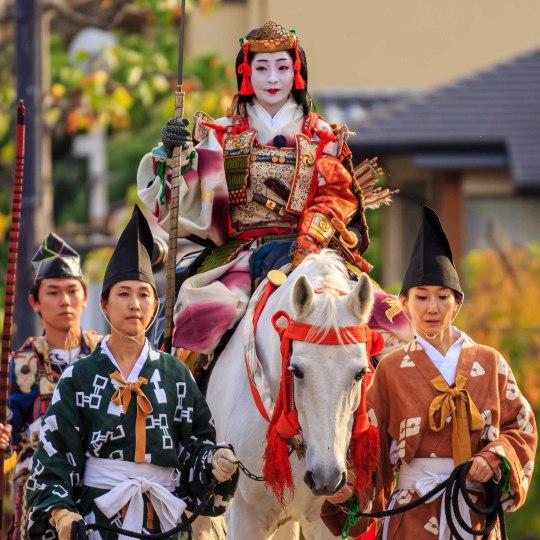
Tomoe Gozen (巴 御前) (1157–1247); was a late twelfth-century female samurai warrior known for her bravery and strength. She is believed to have fought in and survived the Genpei War. She was also the concubine of Minamoto no Yoshinaka. According to one historical account, Tomoe was beautiful, with white skin, long hair, and charming features. She was also a remarkably strong archer, and as a swordswoman, she was a warrior worth a thousand, ready to confront a demon or a god, mounted or on foot. She handled unbroken horses with superb skill; she rode unscathed down perilous descents. Whenever a battle was imminent, Yoshinaka sent her out as his first captain, equipped with strong armour, an oversized sword, and a mighty bow; and she performed more deeds of valour than any of his other warriors (The Tale of the Heike).
652 notes
·
View notes
Photo


Japanese Traditional Clothings by Glimja
1. Kohun(tumuli) period : 3~6C
2. Aska - Nara period : 6C~~794
3. Heian period : 794~1192
4. Kamakura - Muromachi period (the early shogunate) : 1185~1573
5. Warring States Period - Sengoku (the middle shogunate) : 1467~1615
6. Edo period (the late shogunate) : 1603~1868
#japan#japanese culture#japanese tradition#japanese clothing#traditional clothing#kohun period#nara period#heian period#muromachi period#sengoku jidai#edo period
69 notes
·
View notes
Text
The Demon Slayer Timeline, part 01
[Lots of spoilers for obvious reasons]
The Demon Slayer Timeline is actually, a really long one. While it does not follow the totality of the Japanese history, it follows closely the beginning and falling of the Samurai era. While the main plot takes place in the Taisho Era [1912-1924], Sumiyoshi Kamado and Yoriichi Tsugikuni take us to the Sengoku Jidai [1467-1563], and Muzan to the Heian Era [794-1192] ( Muzan drop that skincare routine). But let us start from the beginning.
Muzan says that he was turned into a demon by a doctor in the Heian Era.

The Heian Era [c.794-1192] is today regarded as one of the times of highest culture, even though it was one of the [many] times of political and military conflicts. After conflits between the imperial court and the Buddhist sects that were starting to have way too much power the capital was moved from Nara to Heian-kyo - today known as Kyoto - to be safely way. That said, it also started a religious reform with the introduction of new kinds of Buddhism. [with less interest in power obviously, but still kept at a safe distance of the court] Tendai Buddhism and the Pure land Buddhism would start gain attention during this times and the temples would open their doors to every one of every type of social class [as we can see with Gyomei Himejima, the Rock Hashira that was a blind man that took care of orphan children in a Buddhist temple].
The temples stop having political power, but they also stop having financial aid. So, to survive they had to start exploring the natural resources of their territories. It's not going to take long before the temples start to argue about say territories, and to protect them, they will start to train the farmers that inhabited it, creating what would become a military class.
In 'other hand, in the capital we see a court that is way to centred on herself. The Fujiwara clan was the family with the biggest amount of power. Fujiwara women would marry into the Imperial family in a what could be called genetic colonialization. In the 10th century the Imperial household could not function without the Fujiwara one, starting the tradition were until they reached adulthood the emperor had a Fujiwara regent, so basically it was the Fujiwara that ruled not the Imperial family. But, after 170 years, in 1068 an emperor without a Fujiwara mother sits on the chrysanthemum throne. Go-Sanjo would start to eradicate the Fujiwara by abdicating, leaving the throne to his already adult son. And the same would happen for the next 2 emperors. But by starting to cut ties with the Fujiwara, the imperial family cut off his right arm, and the arm that had the military power, nonetheless.
Japanese had a natural border against enemies, that also meant that they did not have to where to expand their natural territory. So, without new territories to be conquered, the only solution was to start fighting each other for the lands that existed. The families that lived far from the capital were old families that knew their territories like the palm of their hands. With the crescent responsibilities of safeguarding their territories, like with the temples, this Shoen [local provinces] start to train their inhabitants [just like the temples]. We start to see the conquest of territories, and when a clan was defeated, the warriors would start to serve the winning clan. It's the birth of the Samurai Code.
In the 12th century we start to have clans that are ready to go against the imperial court. In 1160 we have the Heiji war, were the Minamoto and Taiga clans are confronting each-other at the capital, and the Taiga family wins, and with entering the court life would become an exact copy of the Fujiwara. The only heir and survivor of the Minamoto clan starts to see the military machine of the Taiga to transform into an aristocratic one wand waits until 1180 to strike back. In 1185 the Minamoto would win the Genpei war staring the 1st ever Shogunate rule.
When Tanjiro goes to the Swordsmith, village, he encounters the mechanical doll made by Kotatsu’s ancestors called “Yoruichii Type Zero” where he goes on saying that that face is familiar to him and Kotatsu says that that technology is from the Sengoku Era.
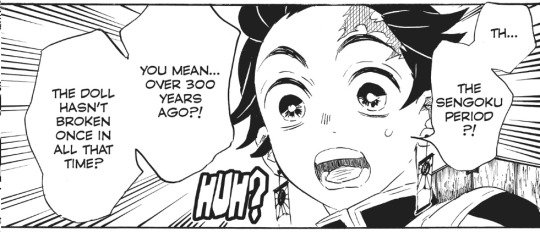
Then after that we start to see Tanjiro’s flash backs of his ancestor Sumiyoshi Kamado and his encounter with Yoriichi Tsugikuni and all of that is confirmed with the backstory of Upper Moon 01 - Kokushibo.

Now, what was the Sengoku Era? Also known as the “warring states era”, the Sengoku-Jidai [c.1467-1573] was the time where the Japanese archipelago was buried on the total anarchy that was the civil war. So, we have a circa 275 years jump.
After the failed rule of the Ashikaga Shogun [Yes because history spoilers, after the Minamoto Shogunate there was more was, more war, and another Shogun], the daimyo [local governors] continue to train their locals to defend their territory. Thanks to the fidelity bonds, the commoners responded to their daimyo, while the daimyo had to respond to the Shogun. Since the Shogun [we don’t even talk about the emperor since he was basically a poppet] no longer protected the daimyos they started to rebel against him saying that he was the first that broke the fidelity law. The commoners, started to learn specific combat techniques - the Kenjutsu, art of the sword - and would develop to what we know call samurai. The word samurai comes from the word “saburau” which means “to serve”, the rising of the samurai class marks the beginning of the feudal era in Japan. At the beginning, these warriors could have two jobs - be warriors and farmers as an example. When Hideyoshi (we will soon talk about him) came to power he required that they choose one or the other, but as long as a samurai remained loyal they were guaranteed a good life.
The samurai's weapon of choice was a 2-sword combination. The 1st one, was the combat sword, a long one called (surprise) Katana. The 2nd one was a small curved one called Wakizaki that served to cut one’s stomach (note: important I tell you).
Now, while everyone was fighting each other for territory, a man in the middle of the territory started what would soon become the union of Japan. Oda Nobunaga [織田 信長 1534-1582], as the eldest son that everyone thought would not do much. Turns out he collaborated with his uncle to kill his brother, to then kill said uncle. At 25 years old no one was bad mouthing him in Owari anymore. He started then to expand his territories were battle after battle he seemed unstoppable.
Then Nobunaga’s troops were defeated for the 1st time, and Akeshi Mitsuhide [明智光秀 1528-1582] would profit this momentarily loss of confidence on Nobunaga to obligate him to commit suicide. But Mitsuhide's victory was short lived since Toyotomi Hideyoshi [豊臣 秀吉 1527-1598], learning what had succeeded rushed to confront Mitsuhide, ending up defeating him. (Man, I love telling everyone this part cause this is what I call plot twist after plot twist! And we aren't finished yet!) Hideyoshi would be de one finishing what Nobunaga started and re-uniting wall the territory under one ruler.
But, after Hideyoshi's dead, his son was still a minor (literally a baby). He would go on naming 5 daimyos as regents in case 1 rebelled the other 4 would protect the heir. Still that did not stop Tokugawa Ieyasu [徳川家康 1543-1616] from rebelling. At 1600 Tokugawa would win the legendary Sekigahara battle, and in 1603 he would (not so kindly) ask the emperor for the Shogun title. He would go on to establish the longest Shogunate in Japanese history. So as the saying goes: “Nobunaga oiled the national rice cake, Hideyoshi kneaded the dough and, in the end, Ieyasu at down and gobbled it up”.
Bibliography:
CHAPLIN, Danny. 2018- Sengoku Jidai: Nobunaga, Hideyoshi and Ieyasu: the three unifiers of Japan. CreateSpace Independent Publishing Platform. Ebook;
CLEMENTS, Jonathan. 2017 - A Brief History of Japan: Samurai, Shogun and Zen. The extraordinary story of the land of the rising sun. Clarendon: Tuttle Publishing.Ebook;
HILLSBOROUGH, Romulus. 2017 - Samurai Assassins: "Dark Murder" and the Meiji restoration, 1853-1868. Jefferson: McFarland & Company. Ebook;
MANSON, R.H.P ; CAIGER, J.G. 1997 - A History of Japan. Clarendon: Tuttle Publishing, 1997. Ebook;
#demon slayer#demon slayer history#demonslayerfromhistorytofantasy#demon slayer from history to fantasy#japanese history#history#research#history research#kimetsu no yaiba#kamado tanjiro#muzan kibutsuji#sumiyoshi kamado#yoriichi tsugikuni
34 notes
·
View notes
Photo

Époque Sengoku
L'époque Sengoku (Sengoku Jidai, 1467-1568), également connue sous le nom de période des États combattants, fut une période turbulente et violente de l'histoire japonaise au cours de laquelle des seigneurs de guerre ou daimyo rivaux se livrèrent une lutte acharnée pour le contrôle du Japon. Cette période s'inscrit dans la période Muromachi (Muromachi Jidai, 1333-1573) de l'histoire médiévale japonaise, lorsque la capitale du shogun Ashikaga était située dans la région Muromachi de Heian-kyō (Kyoto). Le début de l'époque Sengoku fut marqué par la guerre d'Ōnin (1467-1477) qui détruisit Heian-kyō. Les combats qui suivirent au cours du siècle suivant finirent par réduire le nombre de seigneurs de la guerre à quelques centaines, car le pays fut découpé en princes. Finalement, un seigneur de guerre s'éleva au-dessus de tous ses rivaux: Oda Nobunaga, qui mit le Japon sur la voie de l'unification à partir de 1568.
Lire la suite...
4 notes
·
View notes
Text

Tomoe Gozen pictured holding a naginata weapon in her left hand while riding a white horse, painted by Miki Suizan in early 20th century.
This painting is not of a geiko per se but we felt it was fitting to write about one of the more popular historical figures in the Jidai matsuri (held tomorrow).
As is the case with many historical figures, not much is truly known about Tomoe Gozen, her life as a onna musha (female warrior) is shrouded in legend and creative storytelling, influencing many works of literature, poetry, music and even pop culture.
What we do understand about her is that she served under the Heian warlord Minamoto no Yoshinaka during the Genpai War (late 12th century). Yoshinaka would often send Tomoe Gozen into battle as his right hand, she took many heads and won many battles for him.
In the Tale of Heike, it is said that Tomoe Gozen was a remarkable archer, and she was a warrior worth a thousand men when wielding the sword (her preferred weapon of choice.) Tomoe Gozen came from a family who had close connections with Yoshinaka, her elder brothers also served Yoshinaka as generals. She was said to be as beautiful as she was skilled as a fighter.
It is unknown exactly what happened to Tomoe Gozen after her master master Yoshinaka is killed in battle, there are many colourful poetic stories. However, history hasn’t always been so kind to the onna musha, many plays portray Tomoe Gozen in a more socially acceptable female-role with feminine attributes of wielding the naginata, or exaggeratingly helpless or confused rather than being a fearsome warrior. What-ever the truth of Tomoe Gozen’s life her legend continues to be remembered each year through the Jidai matsuri “festival of the ages”.
18 notes
·
View notes
Text
Kuon researching part 2




Synopsis
Setting
Kuon takes place in and around Fujiwara Manor, an estate in Kyoto, Japan during the Heian period. Central to the plot are two magical Mulberry trees planted near the present Fujiwara Manor by the Hata clan. The trees birth silkworms which weave cocoons around the dead and resurrect them. The resurrection can only be sustained by merging with other living beings, including humans, and absorbing their "grudge". The ultimate goal of the Mulberries is to perform the merging nine times, completing the Kuon Ritual and birthing a being which will become a new Mulberry.
Heian period

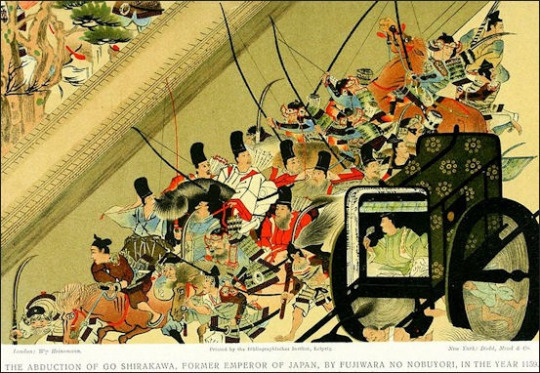
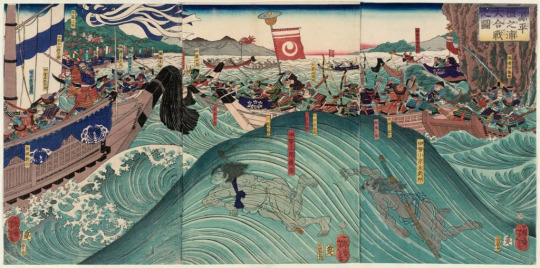
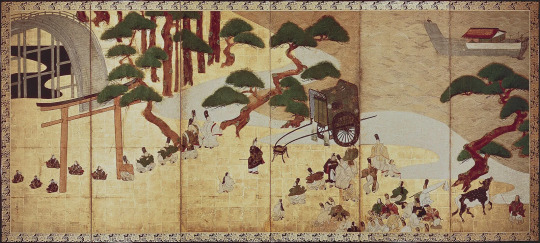
The Heian period (平安時代, Heian jidai) is the last division of classical Japanese history, running from 794 to 1185. It followed the Nara period, beginning when the 50th emperor, Emperor Kammu, moved the capital of Japan to Heian-kyō (modern Kyoto). Heian (平安) means "peace" in Japanese. It is a period in Japanese history when the Chinese influences were in decline and the national culture matured. The Heian period is also considered the peak of the Japanese imperial court, noted for its art, especially poetry and literature. Two types of Japanese script emerged, including katakana, a phonetic script which was abbreviated into hiragana, both unique syllabaries distinctive to Japan.
Character
Many of the characters are either qualified or trainee onmyōji—referred to in the English version as exorcists—practitioners of mystical onmyōdō powers. A key character and antagonist is Ashiya Doman, an ambitious onmyōji who becomes fascinated by the Mulberry tree and the Kuon Ritual. The playable characters are Utsuki, Doman's daughter who lives near one of the Mulberry trees with her sister Kureha; Sakuya, an onmyōji-in-training and one of Doman's apprentices; and Abe no Seimei, a master onmyōji and Doman's rival.
Plot
The narrative is split into three parts; the "Yin" phase following Utsuki, the "Yang" phase following Sakuya, and the unlockable "Kuon" phase following Abe no Seimei. Utsuki and Kureha arrive at Fujiwara Manor from their home in search of Doman. Utsuki is soon separated from Kureha, and must defend herself from the many monsters roaming the grounds.
Sakuya arrives with three of Doman's disciples, including her brother, to investigate the recent rumors of terrible incidents. As they investigate, Sakuya fights off the monsters, and two of the disciples are killed and corrupted by the monsters.
During their explorations, Utsuki and Sakuya find notes by Doman and members of the Fujiwara clan. It is revealed that when Kureha died in an accident for which Utsuki is presumed responsible, Doman was tempted by the Mulberries' twin spirits to subject Kureha to the Kuon Ritual, performed using a special chest. Doman also subjected members of the Fujiwara family to the ritual, with they and other victims returning as monsters. During her exploration, Sakuya burns one of the Mulberry trees.
Utsuki is revealed to have already been absorbed by Kureha, with most of her narrative being a dream during her absorption. Utsuki awakes, struggling against Kureha's influence, and ends up absorbing Sakuya's older brother. Both reach the underground chamber where Doman's experiments were conducted, and despite the monstrous Utsuki attacking her, Sakuya vows to help her.
Alerted to Doman's actions, Abe no Seimei arrives and makes her way through the Fujiwara estate, coming across a wounded Sakuya, who begs Abe no Seimei to help Utsuki. Abe no Seimei also comes across a weakened Utsuki, who is momentarily calmed. Confronting Doman, he reveals his wish for Abe no Seimei to become the Kuon Ritual's ninth and final sacrifice.
Alerted to Doman's actions, Abe no Seimei arrives and makes her way through the Fujiwara estate, coming across a wounded Sakuya, who begs Abe no Seimei to help Utsuki. Abe no Seimei also comes across a weakened Utsuki, who is momentarily calmed. Confronting Doman, he reveals his wish for Abe no Seimei to become the Kuon Ritual's ninth and final sacrifice.
Abe no Seimei kills Doman, then the possessed Utsuki takes Doman's body and enters the prepared chest, beginning the final stage of the Kuon Ritual. Abe no Seimei seals the surviving Mulberry's power, but is stopped by Sakuya from killing Utsuki. Abe no Seimei leaves, warning Sakuya of the new being's potential for evil. During the credits, Sakuya coaxes the Kuon Ritual's child, a young girl resembling Utsuki, outside the Fujiwara grounds for the first time. They walk away together, leaving their futures uncertain.
Development
Kuon was developed by FromSoftware, a company that made its name developing the King's Field and Armored Core series. The producer was Atsushi Taniguchi, who had previously worked on The Adventures of Cookie & Cream for PlayStation 2, and Lost Kingdoms for GameCube. The art director was Nozomu Iwai. Work on Kuon began following Lost Kingdoms II in 2003, with the target audience being people wanting a new approach to horror. Having previously handled dark adventure-based titles before, Taniguchi wanted to create his own take on that style using a traditional Japanese setting.
The battle system was an evolution of the card system from Lost Kingdoms. The "tempest" and meditation mechanics were designed to produce unease, and while easy to implement were a later addition which threatened to disrupt the production schedule. Taniguchi put a lot of effort into creating an atmosphere of fear.
1 note
·
View note
Text
Time period in japan
Currently researching on the The Kamakura period (鎌倉時代, Kamakura jidai, 1185–1333) and The Heian period (平安時代, Heian jidai 794 to 1185)
0 notes
Text
Jidai is Japanese for "era," and mono means "thing," thus jidaimono refers to a very broad range of plays dealing with samurai warriors and the upper classes, set in a period glamorized by Kabuki playwrights as a golden age of chivalry and heroism.
Jidaimono sets and costumes are spectacular, with characters dressed with a lavish opulence that would actually have been quite impractical in the real world. Movement on stage tends toward stiff formal posture; and the language of the drama, too, as befitting that of heroic and aristocratic character, is formal, elaborate, and difficult to understand, much like Shakespearean English is to the modern audience.
Many jidaimono are set in the late Heian (794-1185) and Kamakura (1185-1336) periods. Others are directly concerned with the Heike-Genji civil wars of the latter part of the twelfth century, which are documented in the famous Heike Monogatari (The Tale of the Heike).
(…)
The practice of setting a story in a previous era, besides tending to glamorize the event, also served the more serious purpose of evading the censor. The Shogunate tried to impose strict controls over the people and the information available to them. Playwrights and actors who wished to dramatize a contemporary event escaped censorship by changing the names and setting the story in a previous era.
0 notes
Text
Kannin: Keep Going!
Theme for 2023 is Kannin, keep going!
With my brother-in-arms Pedro, and a few others, we had the chance to share lunch with Sensei. During this time, he said, “this year, the important is Kannin, keep going.” (1)
There are several meanings to Kannin. Kannin refers to a period in Japanese history at the beginning of the 11th century (1017-1021). (2)
Then during the Heian Jidai, it became a generic term referring to the officials…

View On WordPress
0 notes
Text
me when I see an opening to info drop about heian jidai at work

#jassi rants#let me in let me IIIIIIIIIN#jk this is my text i can let myself in >:3#im so annoying abt this hehe <3#cant info drop much but i can mention it and that makes me happy
0 notes
Text
The Jidai Matsuri Festival
The Jidai Matsuri Festival
Heian Fujiwara
Row of Fujiwara court nobles (Fujiwara period) This represents the imperial court customs of the Fujiwara clan in their heyday, when the influence of the Tang style faded away and a unique Japanese “national culture” developed after the mid-Heian period, and represents the summer formal wear of civilian and military officials.
youtube
View On WordPress
0 notes
Photo

Princess Kazunomiya (和宮 親子内親王) was chaperoned by two beautifully dressed ladies during the Jidai Matsuri (時代祭り), the “Festival of Ages” in Kyoto City! Princess Kazunomiya was the younger half-sister of Emperor Kōmei (孝明天皇) and was married to Shogun Tokugawa Iemochi (徳川 家茂) at age 16. She wears a 12-layer kimono. She was an excellent calligrapher and highly regarded as a waka poet.
61 notes
·
View notes
Video
Jidai Matsuri in Kyoto by Japan Culture Spotlight
For over 100 years Kyoto has celebrated its history with an elaborate parade from the Imperial Palace to Heian Jingu . The grounds of the Imperial Palace , known in Japanese as Kyoto Gosho, fill with eager spectators waiting to watch more than 2,000 people dressed in historically accurate costumes.
Held annually in October. The event returns this October 23.
More info : LIVE JAPAN
#jidai matsuri#matsuri#japanese festival#japan matsuri#japan festival#japanese culture#japanese tradition#kyoto#kyoto imperial palace#heian jingu#kyoto gosho#japan#only in japan#japan culture spotlight
6 notes
·
View notes
Text
The Jidai Matsuri Festival
The Jidai Matsuri Festival
Heian Fujiwara
Row of Fujiwara court nobles (Fujiwara period) This represents the imperial court customs of the Fujiwara clan in their heyday, when the influence of the Tang style faded away and a unique Japanese “national culture” developed after the mid-Heian period, and represents the summer formal wear of civilian and military officials.
youtube
View On WordPress
0 notes
Text
Desfile do "Festival das Eras" retorna a Kyoto depois de 3 anos
Desfile do “Festival das Eras” retorna a Kyoto depois de 3 anos
Desfile do “Festival das Eras” retorna a Kyoto depois de 3 anos
Um grande festival voltou à antiga capital japonesa de Kyoto, depois do desfile ter sido cancelado por dois anos consecutivos, devido à pandemia do coronavírus chinês.
Cerca de 2.000 pessoas desfilaram ao longo de uma rota, do Palácio Imperial de Kyoto até o Santuário Heian Jingu, como parte do Jidai Matsuri, ou o Festival das Eras,…
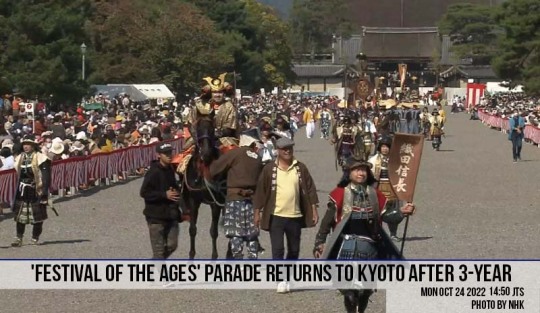
View On WordPress
0 notes